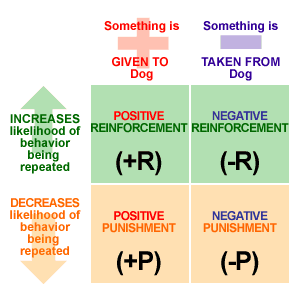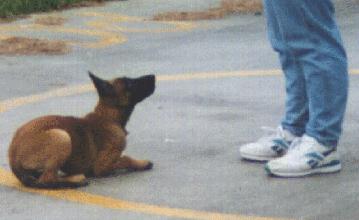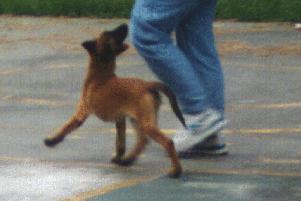OC and the Malinois
Alix is a good example of a wholly OC trained dog. Using Operant Conditioning (OC) methods of training, emphasizing learning through Positive Reinforcement, Ali quickly learned to recall (voice and whistle), sit, come to front, down, do the dogwalk and a-frame (agility), heel, and potty on command by the age of 12 weeks. By 7 months we’d added tracking articles, utility scent discrimination, and more.
It’s important to mention, right away, that Operant Conditioning, Positive Reinforcement, and "Clicker Training" are not synonomous terms. Operant Conditioning refers to using the laws of learning—that means positive reinforcement, negative reinforcement, positive punishment, and negative punishment—so you shouldn’t say you are training using operant conditioning if you are only using positive reinforcement.
Positive reinforcement is only one quadrant of operant conditioning. I consider myself a clicker trainer. But I utilize the full spectrum of OC. I use positive reinforcement to teach almost everything. That allows me to use little negative reinforcement or positive punishment. But I do use negative reinforcement, mostly for proofing. I have also been known to use positive punishment. There are just some things that need to be dealt with positively and immediately.
The "Operant Conditioning Spectrum" looks something like:

Notice the way the color pairs work. Positive refers to giving something to the dog. Negative refers to taking something away from the dog. Reinforcement is responsible for increasing a behavior, while Punishment has the effect of decreasing a behavior. People can get pretty emotional about this, because the terms entered the mainstream dog vocabulary without being truly understood. The most abused are the terms "negative" and "positive"—which have nothing to do with "bad" or "good"…simply whether something is taken away or given.
If you give a cookie to a dog, you are not necessarily positively reinforcing the dog. If the behavior (whatever reason you gave the dog the cookie) doesn’t increase, you have NOT effectively positively reinforced the behavior. If you whack your dog for sniffing another dog’s butt (you are giving the dog something in hopes of decreasing the behavior—let’s all say Positive Punishment), but the dog doesn’t change its buttsniffing behavior, you have NOT effectively punished the behavior. You’re throwing cookies or whacks to the wind. They aren’t accomplishing anything.
In Operant Conditioning, everything revolves around the dog’s perception of things. What you think should be reinforcing to the dog is hogwash—what the dog finds reinforcing is paramount. The same goes for punishment. I have a dog that does NOT consider a squirt of water in the face to be aversive. She likes it. Do you think I can use a spray bottle to stop her from getting on the counter, or stepping over a boundary? Not a chance. It would not effectively decrease the behavior I’m trying to decrease—in fact, it might reinforce the behavior!
A good rule of thumb in reinforcement is that if it doesn’t do the job in three repetitions, you need to find something else. The same goes for punishment. If it doesn’t work in three reps, whatever you are using is NOT decreasing the behavior—try something else.
Operant Conditioning, Applied
Here are some pictures taken when Alix was 11 weeks old. Notice the attention and precision—puppies can be happy and precise workers, without "ruining their spirit" if training is approached the right way. Ali was my first totally clicker dog—I’d taken dogs with previous training and converted them (called "crossover" dogs), but never started fresh with a puppy. I will always start a new dog off this way in the future, and if I ever breed, the puppies will be started before they go off into the world"it’s too much fun and too valuable a tool to wait!



I brought Alix home at nine weeks, and I’ll confess, I didn’t even think of going ahead and conditioning a reinforcer until a week later. Within three reps, she knew what the click was, and, being so insistent, the "front" was the first behavior Alix offered.
I decided to teach the down next, and after years of teaching a dog to do an "Elbows" Down, meaning pounce forward into the down, I decided to teach the Foldback Down, where (as you can see in the picture) the dog literally folds back into the down.
Both are equally speedy, but my intention to show her in French Ring, with its Position Change exercise, really made up my mind. In the Position Change, the handler gives six position change commands, drawn at random before starting, consisting of sit, down, and stand. The dog loses points for moving forward, hence my reasoning for teaching the Foldback Down.
Probably because of the Malinois’ herding background, she offered the heel position very early on. This, for me, was the most interesting thing to teach. I simply let her offer behaviors and clicked when she was in correct position and looking up at me.
You could almost see the wheels turning in her head. She first heeled on the left – *click*, then on the right – no click, then in front walking backwards and watching me – no click, then behind me (presumably) watching me – no click, then back to the left for a *click* again! Once she figured THAT out, she had a great time offering prancing, high-tail, etc…which I clicked when appropriate.
I think most clicker purists teach heeling with a target stick—teaching the dog to follow a pointer, and using the pointer to guide the dog into proper position. Sticks and Malinois = overstimuluation. Alix kept stealing my target stick, never content to just touch it, she had to have it. I brought out the target stick again at about 8 months, to train her to turn light switches on and off. It worked better, but the stick does excite her and get her a bit too revved up.
Probably the biggest advantage of clicker training, particularly with "naive" dogs (dogs with no prior obedience training) is the mindset that accompanies it. In traditional dog training, the dog learns that unless it is where the handler tells it, it is wrong. So when the dog is confused or uncertain, it simply freezes. In clicker training, the dog is encouraged to be creative and figure things out. A clicker-savvy dog simply keeps trying—if one thing doesn’t work, another will surely bring a click and treat, right? This makes training complex behaviors and tricks much, much simpler. Rather than freezing when something new happens, the dog adjusts and even capitalizes on it.
For more information on Clicker Training, see my links under Performance. For some amazing video of working dogs trained using OC, see the Sprite Tervuren Video Gallery.
